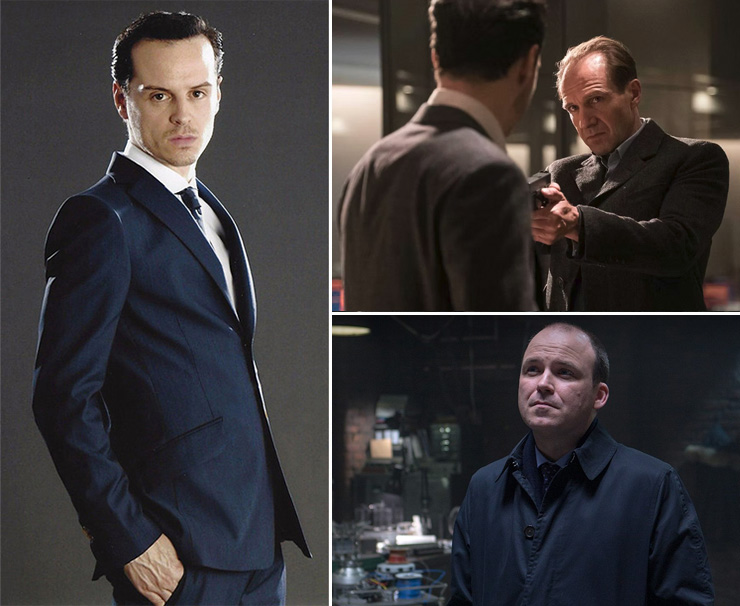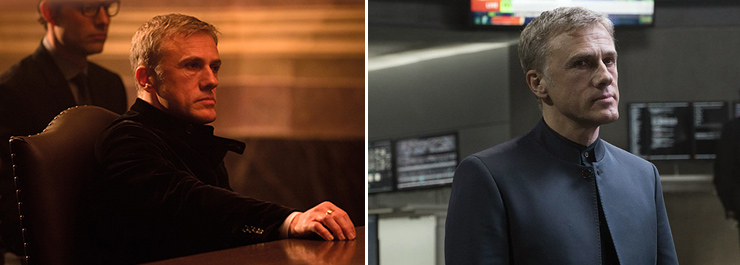|
Spectre |
||
|
||
|
Spectre |
||
|
||
 |
|||
|
KEVIN HARPER looks back at the making of Spectre, released 10 years ago as the 24th entry in the long-running EON Productions James Bond film series. After a lengthy and troubled production Daniel Craig’s fourth 007 outing finally hit cinema screens in October 2015 – three years after the blockbusting Skyfall, which by then had grossed over $1.1 billion at the global box-office. |
|||
|
|||
|
Following the spectacular success of Skyfall (2012), studios MGM and SONY wanted more of the same, and co-producers Michael G. Wilson & Barbara Broccoli were keen for director Sam Mendes to return, as he was one of the key architects in the reinvention of the franchise for a whole new generation. The first three Daniel Craig 007 films had seen the introduction of a new iteration of the main character, and the return of key elements such as the Aston Martin DB5, new interpretations of Moneypenny and Q, and a clever mix of nostalgia and modernity that clearly appealed to casual fans as well as the seasoned veterans who had stuck with the franchise since its early days. |
|||
|
|||
|
As part of the updating of the series, Skyfall co-screenwriter John Logan was keen to reintroduce audiences to James Bond’s long-time nemesis Ernst Stavro Blofeld. However, this was a problem as the rights to the character and his crime organisation SPECTRE were then held by the estate of Kevin McClory (1924-2006). Undeterred, John Logan submitted a first draft screenplay which included Blofeld, whilst in the background David Pope, CEO of DANJAQ (the company responsible for the copyright and trademarks to the characters, elements, and other material related to James Bond on screen) pursued the rights with the McClory estate. Sam Mendes initially ruled himself out of the running to be the first man since John Glen to direct successive Bond films, declaring in March 2013: ‘‘Directing Skyfall was one of the best experiences of my professional life, but I have theatre and other commitments… that need my complete focus over the next year and beyond.” Co-producers Wilson & Broccoli agreed to wait until Mendes was available and pushed the release date of the next Bond film to October 2015. Mendes was finally announced as the director of BOND 24 on July 11, 2013. During the extended pre-production period DANJAQ announced on October 13, 2013, that they had finally secured from the estate of the late Kevin McClory the long-disputed rights to Thunderball, and all properties associated with it, notably the villainous organisation SPECTRE and its head, the iconic Ernst Stavro Blofeld. |
|||
|
|||
|
During pre-production, returning Production Designer Dennis Gassner scouted locations in Morocco, Switzerland, Austria, and Italy. Back in the UK Sam Mendes and Special Effects Supervisor Chris Corbould visited Aston Martin’s headquarters at Gaydon in Warwickshire, where they saw early concepts of what became the DB10, and the luxury car manufacturer agreed to make 10 cars for use in the new James Bond film. Casting got underway in April 2014, and French actress Léa Seydoux secured the key role of Madeleine Swann (Mr. White’s daughter) after a meeting with Sam Mendes. At this stage the production was using John Logan’s first full script titled ‘The Death Collector’ (a direct reference to Shatterhand/Blofeld and the title of Chapter Seven of Ian Fleming’s 1964 novel YOU ONLY LIVE TWICE), which opened with an action sequence at a ‘Day of the Dead’ celebration, although set in Cuba at this stage. |
|||
 |
|||
|
A spectacular car chase was later changed to a fight in a helicopter between James Bond and Marco Sciarra above Zócalo Square in Mexico City. However, at this stage executives at SONY began to lose faith in the John Logan script and brought back long-time Bond co-screenwriters Neal Purvis & Robert Wade, who worked on a revised screenplay that was ultimately polished by British playwright Jez Butterworth, who had also made uncredited contributions to Skyfall (2012). Other controversial elements of Logan’s screenplay were jettisoned, including his initial concept for a shock twist in the film where Bond’s arch-nemesis was to be revealed as a woman. Ralph Fiennes himself vetoed the idea of M turning out to be a traitor. A similar notion – that Tanner (played by Rory Kinnear) was a SPECTRE mole – was also abandoned, with the new character Max Denbigh, known as ‘C’ (played by Andrew Scott), taking on that role in the story. At one point, it was suggested that Blofeld might be portrayed as an African warlord or dictator, with Oscar-nominated British-Nigerian actor Chiwetel Ejiofor reportedly linked to the part. John Logan’s initial drafts also included the characters Felix Leiter and Irma Bunt. Due to the lack of a final workable script, even director Sam Mendes and actor (and now co-producer) Daniel Craig contributed to the development of the story. By August 2013, the screenplay seemed to be progressing in a more positive direction, as the creative team wrestled with how to integrate the back-story from Bond’s childhood and the introduction of SPECTRE, and possibly Blofeld, while also reconciling all these story beats with threads from the three previous Craig 007 films. It was at this point the screenwriters provided a major retcon to the events of the previous films, with the Quantum organisation alluded to in Casino Royale (2006) and introduced in Quantum of Solace (2008) reimagined as a division within SPECTRE rather than an independent organisation, which is implied to be no longer active. The plot of Spectre (2015) also linked the events of Skyfall (2012) to Craig's first two 007 films by revealing antagonist Raoul Silva (played by Javier Bardem) to be associated with SPECTRE, thereby changing the standalone status of that film. Craig’s next (and final) James Bond film, No Time To Die (2021), went even further with retroactive continuity, and ultimately linked all five of his 007 films into one narrative, consolidating his tenure as a standalone story-arc, irrespective that other elements from earlier non-Craig Bond films were referenced or even appeared on screen. |
|||
 |
|
The final version of the Spectre screenplay followed up on the events of Skyfall and expanded the details surrounding Bond’s childhood, and that he had a father figure called Hannes Oberhauser (a character created by Ian Fleming and who appears in Fleming’s 1962 short story OCTOPUSSY). Spectre reveals that Oberhauser’s son Franz resented Bond’s intrusion into his family and renamed himself Ernst Stavro Blofeld after killing his father. Cast as Franz Oberhauser, and therefore Bond’s adoptive brother, was respected Oscar-winning Austrian-born actor Christoph Waltz. |
|
|
CONTINUED >> |
|